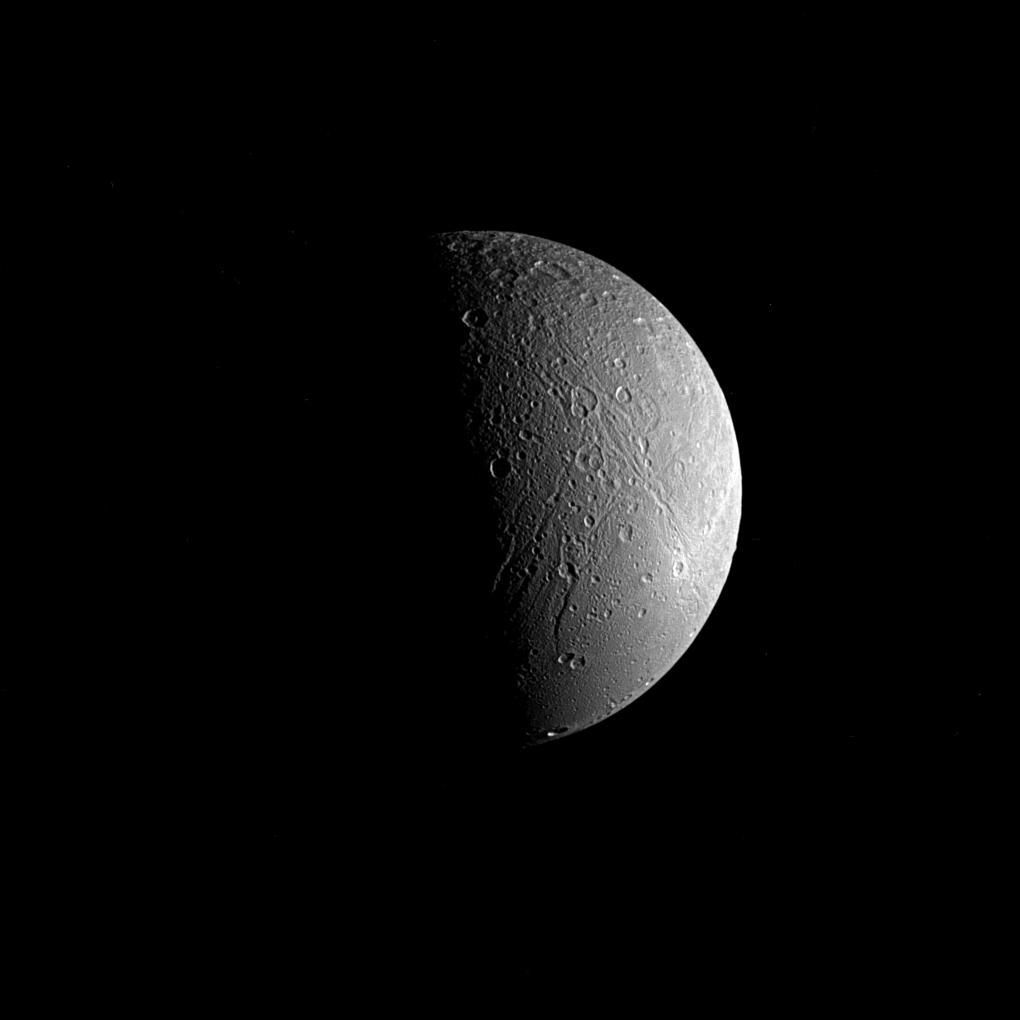Dione

Giovanni Cassini discovered Dione on March 21, 1684.
Dione is a small moon of 349 miles (562 km) in mean radius orbiting Saturn every 2.7 days at a distance of 234,500 miles (377,400 km), which is roughly the same distance that our Moon orbits Earth.
Dione's density is 1.48 times that of liquid water, suggesting that about a third of Dione is made up of a dense core (probably silicate rock) with the remainder of its material being ice. At Dione's average temperature of -304 degrees Fahrenheit (-186 degrees Celsius or 87 kelvins), ice is very hard and behaves like rock.
Very fine ice powder (equivalent to smoke) from Saturn's E-ring constantly bombards Dione. The dust in the E-ring ultimately comes from Enceladus, which has prominent geyser activity.
Dione's features include heavily cratered terrain with craters as large as 62 miles (100 km) across, moderately cratered plains, lightly cratered plains, and fractured areas. The heavily cratered areas are most common on the trailing hemisphere. Logically, a moon's leading hemisphere should be the more heavily cratered, so it has been theorized that a more recent impact spun Dione around. It has been calculated that bodies as small as those that made 22-mile (35-km) craters on Dione could have spun the moon around to its current position. However, the fact that Dione seems to have spun exactly 180 degrees is a mystery.
Fractured areas, seen in Voyager images as bright and thin wispy lines, have lengths of tens to hundreds of miles, often cutting through plains and craters. Cassini flybys starting in 2005 showed "the wisps" as bright canyon ice walls (some of them several hundred meters high), probably caused by subsidence cracking. The walls are bright because darker material falls off them, exposing bright water ice. These fracture cliffs suggest Dione experienced tectonic activity in its past. They could be a mature phase of the so-called tiger stripes on Enceladus.
Just like Earth's Moon, Dione is phase locked with its parent; one side always faces toward Saturn. Likewise, Dione has gravitationally locked two much smaller moons: Helene orbits Saturn 60 degrees ahead of Dione, and Polydeuces orbits Saturn 60 degrees behind Dione. (These tidally locked moon locations are also referred to as Lagrangian points, L4 for the leading spot and L5 for the trailing spot, based on calculations of the French astronomer Joseph-Louis Lagrange in 1772.)
Dione is in resonance with two nearby moons, Mimas and Enceladus. That is, these moons speed up slightly as they approach each other and slow down as they draw away, causing their orbits to vary slightly in a long series of complex changes, which helps keep them locked in their positions. Dione keeps Enceladus locked at a period exactly one half that of its own orbital period.
Cassini referred to Dione as one of the four Sidera Lodoicea (Stars of Louis) after King Louis XIV (the other three were Iapetus, Tethys, and Rhea). Other astronomers called the Saturn moons by number in terms of their distance from Saturn. Thus, Dione was Saturn IV. John Herschel suggested that the moons of Saturn be associated with the Greek mythical brothers and sisters of Kronus. (Kronus is the equivalent of the Roman god Saturn in Greek mythology.) Geological features on Dione generally get their names from people and places in Virgil's "Aeneid." The International Astronomical Union now controls the naming of astronomical bodies.
The name Dione comes from the Greek goddess (or Titan) Dione, who by some accounts was the daughter of Tethys (who is Kronus' sister) and Oceanus, and whom Homer described as the mother of Aphrodite.




